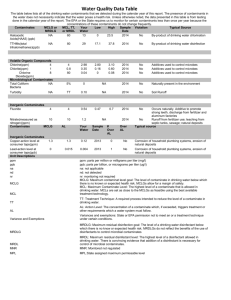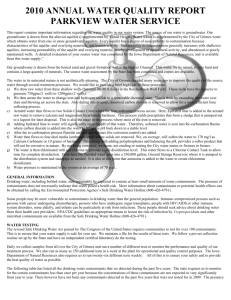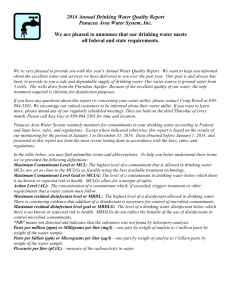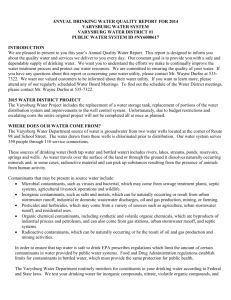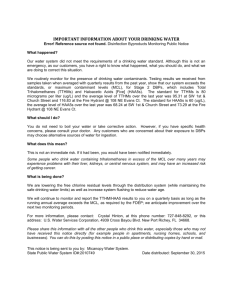2012 - Wagoner County Rural Water District No. 5
advertisement
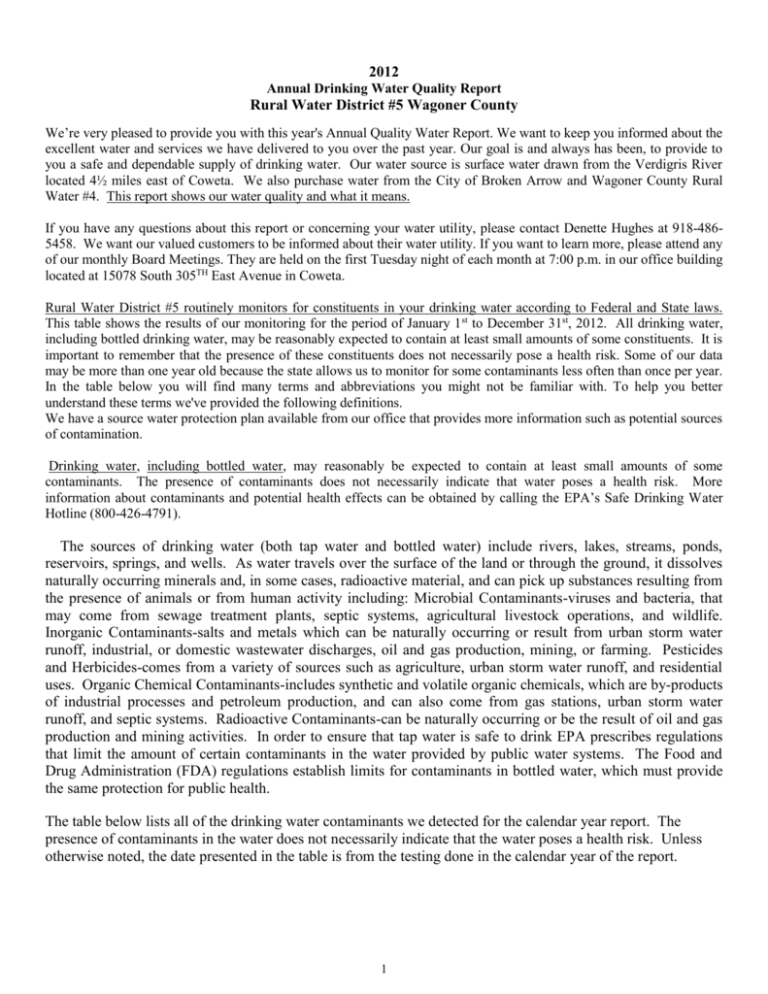
2012 Annual Drinking Water Quality Report Rural Water District #5 Wagoner County We’re very pleased to provide you with this year's Annual Quality Water Report. We want to keep you informed about the excellent water and services we have delivered to you over the past year. Our goal is and always has been, to provide to you a safe and dependable supply of drinking water. Our water source is surface water drawn from the Verdigris River located 4½ miles east of Coweta. We also purchase water from the City of Broken Arrow and Wagoner County Rural Water #4. This report shows our water quality and what it means. If you have any questions about this report or concerning your water utility, please contact Denette Hughes at 918-4865458. We want our valued customers to be informed about their water utility. If you want to learn more, please attend any of our monthly Board Meetings. They are held on the first Tuesday night of each month at 7:00 p.m. in our office building located at 15078 South 305TH East Avenue in Coweta. Rural Water District #5 routinely monitors for constituents in your drinking water according to Federal and State laws. This table shows the results of our monitoring for the period of January 1 st to December 31st, 2012. All drinking water, including bottled drinking water, may be reasonably expected to contain at least small amounts of some constituents. It is important to remember that the presence of these constituents does not necessarily pose a health risk. Some of our data may be more than one year old because the state allows us to monitor for some contaminants less often than once per year. In the table below you will find many terms and abbreviations you might not be familiar with. To help you better understand these terms we've provided the following definitions. We have a source water protection plan available from our office that provides more information such as potential sources of contamination. Drinking water, including bottled water, may reasonably be expected to contain at least small amounts of some contaminants. The presence of contaminants does not necessarily indicate that water poses a health risk. More information about contaminants and potential health effects can be obtained by calling the EPA’s Safe Drinking Water Hotline (800-426-4791). The sources of drinking water (both tap water and bottled water) include rivers, lakes, streams, ponds, reservoirs, springs, and wells. As water travels over the surface of the land or through the ground, it dissolves naturally occurring minerals and, in some cases, radioactive material, and can pick up substances resulting from the presence of animals or from human activity including: Microbial Contaminants-viruses and bacteria, that may come from sewage treatment plants, septic systems, agricultural livestock operations, and wildlife. Inorganic Contaminants-salts and metals which can be naturally occurring or result from urban storm water runoff, industrial, or domestic wastewater discharges, oil and gas production, mining, or farming. Pesticides and Herbicides-comes from a variety of sources such as agriculture, urban storm water runoff, and residential uses. Organic Chemical Contaminants-includes synthetic and volatile organic chemicals, which are by-products of industrial processes and petroleum production, and can also come from gas stations, urban storm water runoff, and septic systems. Radioactive Contaminants-can be naturally occurring or be the result of oil and gas production and mining activities. In order to ensure that tap water is safe to drink EPA prescribes regulations that limit the amount of certain contaminants in the water provided by public water systems. The Food and Drug Administration (FDA) regulations establish limits for contaminants in bottled water, which must provide the same protection for public health. The table below lists all of the drinking water contaminants we detected for the calendar year report. The presence of contaminants in the water does not necessarily indicate that the water poses a health risk. Unless otherwise noted, the date presented in the table is from the testing done in the calendar year of the report. 1 Water Quality Data Table 2012 Wagoner County Rural Water District #5 The table below lists all of the drinking water contaminants that we detected during the calendar year of this report. The presence of contaminants in the water does not necessarily indicate that the water poses a health risk. Unless otherwise noted, the data presented in this table is from testing done in the calendar year of the report. The EPA or the State requires us to monitor for certain contaminants less than once per year because the concentrations of these contaminants do not change frequently. Contaminants MCLG or MRDLG MCL, TT, or MRDL Your Water Range Low High Sample Date Violation Typical Source Disinfectants & Disinfection By-Products (There is convincing evidence that addition of a disinfectant is necessary for control of microbial contaminants.) Haloacetic Acids NA 60 26 17.5 28.9 2012 No By-product of drinking water (HAA5) (ppb) disinfectin. TTHMs [Total NA 80 47 30.7 63.5 2012 No By-product of drinking water Trihalomethanes] (ppb) disinfection. Total Organic Carbon The percentage of Total Organic Carbon (TOC) removal was measured each month and the system met all TOC requirements set, Unless a TOC violation is noted in the violation section. Chlorite (ppm) 0.8 1 0.567 0.249 0.567 2012 No By-product of drinking water Disinfection. Microbiological Contaminants Turbidity (NTU) 100% of the samples were below the TT value of 0.5. 2012 No Soil runoff. A value less than 95% constitutes a TT violation. The highest single measurement was 0.18. Any measurement in excess of 5 is a violation unless otherwise approved by the state. Radioactive Contaminants Beta/photon emitters Mrem/yr 0 4 Combined Radium 226/228 pCi/L 0 5 Contaminants 4.554 4.554 4.554 2011 No Decay of natural and manmade deposits. 0.493 0.493 0.493 2011 No Erosion of natural deposits. MCLG AL Your Water Sample Date # Samples Exceeding AL Exceeds AL 1.3 1.3 0.207 8/24/11 0 No Typical Source Inorganic Contaminants Copper - action level at consumer taps (ppm) For more information contact Denette Hughes P.O. Box 835 Coweta, OK 74429 Phone: 918-486-5458 Fax: 918-486-1440 Email: rural5@valornet.com Website: www.ruralwater5.com 2 Corrosion of household plumbing systems; Erosion of natural deposits. Water Quality Data Table 2012 Wagoner County Rural Water #4 Contaminants MCLG or MRDLG MCL, TT, or MRDL Your Water Range Low High Sample Date Violation Typical Source Disinfectants & Disinfection By-Products (There is convincing evidence that addition of a disinfectant is necessary for control of microbial contaminants.) Haloacetic Acids NA 60 36.1 ND 36.1 2012 No By-product of drinking water (HAA5) (ppb) chlorination Total Organic Carbon NA TT 54 NA 2012 No Naturally present in the (% Removal) environment Inorganic Contaminants Copper source Water (ppm) 1.3 0.661 (MPL) NA 2012 No Lead- source water (ppb) 6.8 6.8 (MPL) NA 2012 No Corrosion of household plumbing systems; Erosion of natural deposits, leaching from wood preservatives. Corrosion of household plumbing systems; Erosion of natural deposits. Microbiological Contaminants Turbidity (NTU) NA 1 95.56 NA 2012 No Soil runoff______________ 95.56% of the samples were below the TT value of 1. A value less than 95% constitutes a TT violation. The highest single measurement was 0.54. Any measurement in excess of 5 is a violation unless otherwise approved by the state. Radioactive Contaminants Beta/photon emitters 0 50 50 NA 2011 No Decay of natural and (pCi/L) man-made deposits. 3 Water Quality Data Table 2012 City of Broken Arrow MCLG MCL, or TT, or Contaminants MRDLG MRDL Disinfectants & Disinfection By-Products Your Water Range Low High Sample Date Violation Typical Source (There is convincing evidence that addition of a disinfectant is necessary for control of microbial contaminants.) Haloacetic Acids (HAA5) (ppb) NA 60 64.23 22.09 64.23 2012 Yes By-product of drinking water chlorination Haloacetic Acids (HAA5) (ppb) NA 60 60.40 22.09 64.23 2012 Yes By-product of drinking water chlorination Haloacetic Acids (HAA5) (ppb) NA 60 60.13 22.09 64.23 2012 Yes By-product of drinking water disinfection Violations and Excedances Haloacetic Acids (HAA5) Some people who drink water containing haloacetic acids in excess of the MCL over many years may have an increased risk of getting cancer. High levels in May 2012 caused the Locational Running Annual Average (LRAA) to exceed the Maximum Contaminant Level (MCL). Water provider (OOWA) was notified and took corrective actions. Unit Descriptions Term ppm ppb pCi/L NTU NA ND NR Definition ppm: parts per million, or milligrams per liter (mg/L) ppb: parts per billion, or micrograms per liter (µg/L) pCi/L: picocuries per liter (a measure of radioactivity) NTU: Nephelometric Turbidity Units. Turbidity is a measure of the cloudiness of the water. We monitor it because it is a good indicator of the effectiveness of our filtration system. NA: not applicable ND: Not detected NR: Monitoring not required, but recommended. Important Drinking Water Definitions Term Definition MCLG MCLG: Maximum Contaminant Level Goal: The level of a contaminant in drinking water below which there is no known or expected risk to health. MCLGs allow for a margin of safety. MCL MCL: Maximum Contaminant Level: The highest level of a contaminant that is allowed in drinking water. MCLs are set as close to the MCLGs as feasible using the best available treatment technology. TT TT: Treatment Technique: A required process intended to reduce the level of a contaminant in drinking water. AL AL: Action Level: The concentration of a contaminant which, if exceeded, triggers treatment or other requirements which a water system must follow. Variances and Exemptions Variances and Exemptions: State or EPA permission not to meet an MCL or a treatment technique under certain conditions. MRDLG MRDLG: Maximum residual disinfection level goal. The level of a drinking water disinfectant below which there is no known or expected risk to health. MRDLGs do not reflect the benefits of the use of disinfectants to control microbial contaminants. MRDL MRDL: Maximum residual disinfectant level. The highest level of a disinfectant allowed in drinking water. There is convincing evidence that addition of a disinfectant is necessary for control of microbial contaminants. MNR MNR: Monitored Not Regulated MPL MPL: State Assigned Maximum Permissible Level 4


